Are you ready to embark on an unforgettable hiking adventure in Kobuk Valley National Park? Located in remote and rustic Arctic Alaska, this vast wilderness offers an array of hiking trails for explorers of all skill levels. Whether you’re a seasoned hiker or new to the trails, Kobuk Valley has something for everyone. Join me as I share the top trails in the park and provide you with seasonal tips to make the most of your hiking experience.
Key Takeaways:
- Explore the diverse wilderness of Kobuk Valley National Park through its hiking trails.
- Choose from easy or hard trails based on your hiking experience and skill level.
- Enjoy the stunning landscapes, unique geological features, and abundant wildlife.
- Plan your trip carefully, considering the seasonal variations and safety precautions.
- Immerse yourself in the rich history and cultural significance of the park.
Easy Hiking Trails in Kobuk Valley National Park

When it comes to exploring the picturesque beauty of Kobuk Valley National Park, there are several easy hiking trails that offer a delightful experience for all skill levels. One such trail is the Great Kobuk Sand Dunes, where visitors can immerse themselves in the breathtaking Arctic landscape. The sand dunes provide a unique backdrop for hikers, offering stunning views and the opportunity to witness the mesmerizing interplay between sand and wind.
Another easy hiking trail worth exploring is Onion Portage, a historically significant site that showcases the migration of caribou. Hikers can witness these majestic creatures as they traverse the river, creating a remarkable spectacle. This trail not only allows visitors to connect with nature but also provides insight into the rich cultural heritage of the Inupiaq Eskimos, who have relied on the caribou for sustenance for thousands of years.
In addition to the Great Kobuk Sand Dunes and Onion Portage, there are many other scenic hikes in Kobuk Valley National Park that offer a tranquil escape into the pristine wilderness. These trails showcase the park’s diverse geological features, including rugged mountains, lush valleys, and majestic rivers. Whether you’re a seasoned hiker or just starting out, these easy trails will leave you with lasting memories of the park’s natural beauty and serenity.
Table: Easy Hiking Trails in Kobuk Valley National Park
| Trail Name | Difficulty Level | Highlights |
|---|---|---|
| Great Kobuk Sand Dunes | Easy | Stunning views of Arctic landscape |
| Onion Portage | Easy | Witness the migration of caribou |
| Other Easy Hiking Trails | Easy | Explore diverse geological features |
Embarking on an easy hike in Kobuk Valley National Park allows you to appreciate the raw beauty of the Arctic wilderness. These trails not only provide an opportunity to connect with nature but also offer a glimpse into the park’s fascinating history and cultural heritage. So grab your hiking boots and explore the easy hiking trails in Kobuk Valley National Park for a memorable outdoor adventure.
Hard Hiking Trails in Kobuk Valley National Park
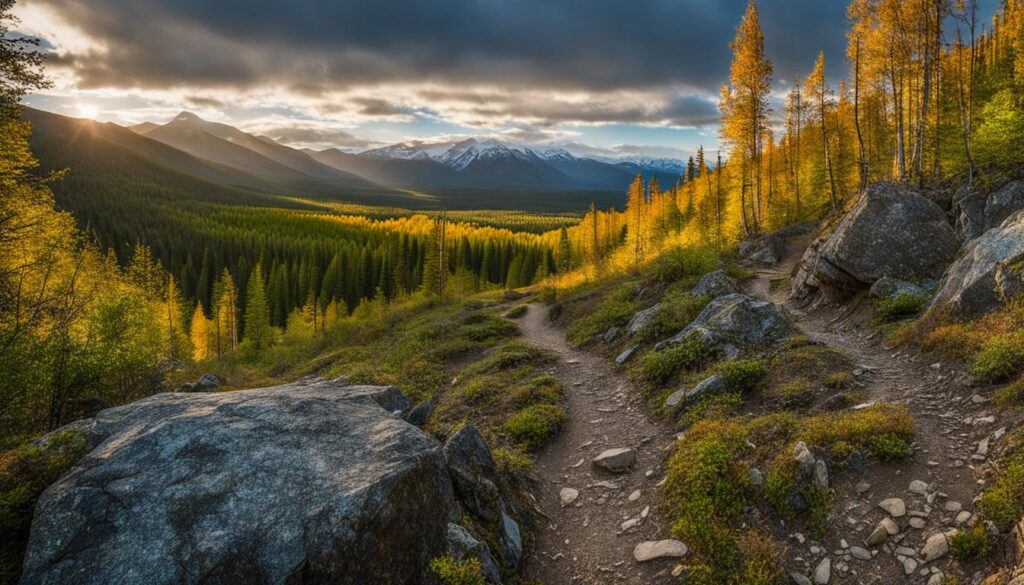
For adventurous hikers seeking a challenge, Kobuk Valley National Park offers a variety of hard hiking trails that will put your skills to the test. These trails are known for their rugged terrain and breathtaking views, providing an unforgettable experience for those willing to push their limits. However, it’s important to note that hiking in these areas requires advanced navigation skills and the ability to navigate off-trail. To ensure your safety, it’s recommended to consult with park rangers and experienced guides before attempting these hikes.
One popular option for hard hikes in Kobuk Valley is the ridgelines of the Baird Mountains. These mountains offer a stunning backdrop and panoramic views of the surrounding landscape. Hiking along the ridgelines provides a challenging and rewarding experience, but be prepared for steep ascents and treacherous descents. Another option for the more daring hiker is the tundra trek to reach the mountains from the river. This off-trail adventure requires careful navigation and a high level of fitness, but the sense of accomplishment upon reaching the mountains is unparalleled.
When embarking on hard hikes in Kobuk Valley, it’s essential to come well-prepared. Be sure to pack appropriate gear, including sturdy hiking boots, plenty of water, extra layers of clothing, and a map or GPS device for navigation. Additionally, familiarize yourself with the park’s safety guidelines and be aware of the potentially dangerous wildlife in the area, such as bears and moose. By taking the necessary precautions and respecting the park’s wilderness, you can embark on an incredible hiking adventure in Kobuk Valley National Park.
Table: Hard Hiking Trails in Kobuk Valley National Park
| Trail Name | Difficulty Level | Trail Features |
|---|---|---|
| Ridgelines of the Baird Mountains | Challenging | Panoramic views, rugged terrain |
| Tundra trek to the mountains from the river | Difficult | Off-trail navigation, remote wilderness |
Embark on a challenging and rewarding adventure in Kobuk Valley National Park by exploring its hard hiking trails. These trails offer a unique opportunity to push your limits, navigate rugged terrain, and soak in breathtaking views. The ridgelines of the Baird Mountains provide a stunning backdrop and panoramic vistas of the surrounding landscape. However, be prepared for steep ascents and treacherous descents along this trail. If you’re up for a more daring adventure, the tundra trek to the mountains from the river offers an off-trail experience that requires advanced navigation skills and a high level of fitness. The sense of accomplishment upon reaching the mountains is unmatched.
When taking on hard hikes in Kobuk Valley, it’s crucial to come prepared. Make sure to have sturdy hiking boots, adequate water, extra layers of clothing, and navigation tools such as a map or GPS device. Additionally, acquaint yourself with the park’s safety guidelines and be mindful of the potential presence of bears and moose, which are part of the park’s wildlife. By taking the necessary precautions and respecting the pristine wilderness, you can embark on an extraordinary hiking journey in Kobuk Valley National Park.
Hiking in Kobuk Valley National Park: Summer vs. Winter
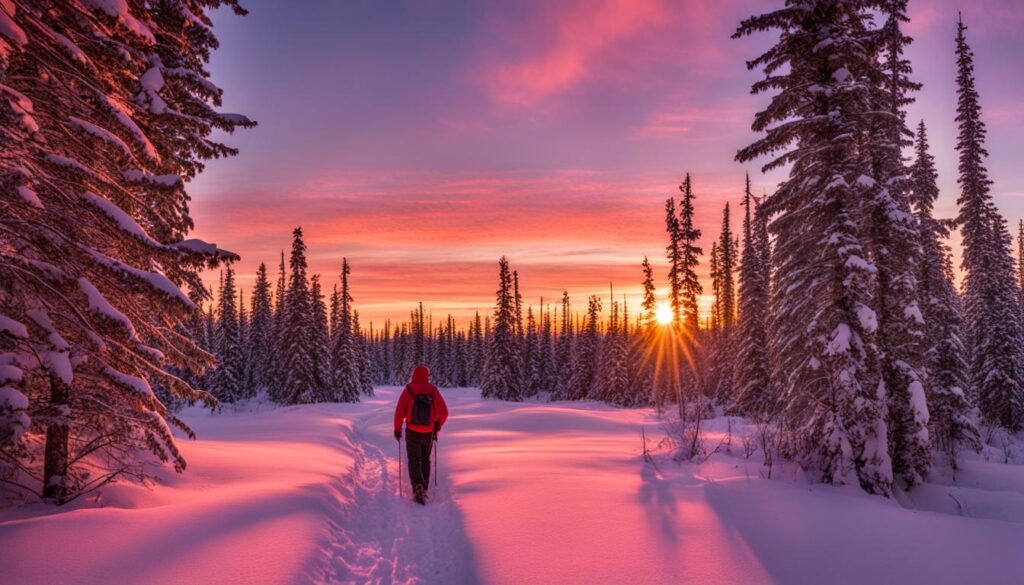
Exploring Kobuk Valley National Park offers a unique experience depending on the season. In the summer months, from mid-June through July, the park comes alive with vibrant wildflowers and a richly diverse landscape. This is the prime time for hiking in Kobuk Valley, as the weather is milder and the longer daylight hours allow for longer excursions. However, as August brings rain and September marks the return of snow, it’s important to plan accordingly.
On the other hand, winter unveils a different facet of Kobuk Valley National Park. The park transforms into a snowy wonderland, offering opportunities for snowshoeing and cross-country skiing. The crisp, cold air and the breathtaking beauty of a snow-covered landscape create a serene and peaceful atmosphere. Additionally, winter provides a chance to witness the stunning Northern Lights, which add a touch of magic to your hiking experience.
Both summer and winter seasons have their own unique charms, and choosing the best time to visit depends on personal preferences and interests. Whether you prefer the vibrant colors and longer days of summer or the serene beauty and enchantment of a winter wonderland, Kobuk Valley National Park has something to offer all nature enthusiasts.
Historical Significance of Kobuk Valley National Park
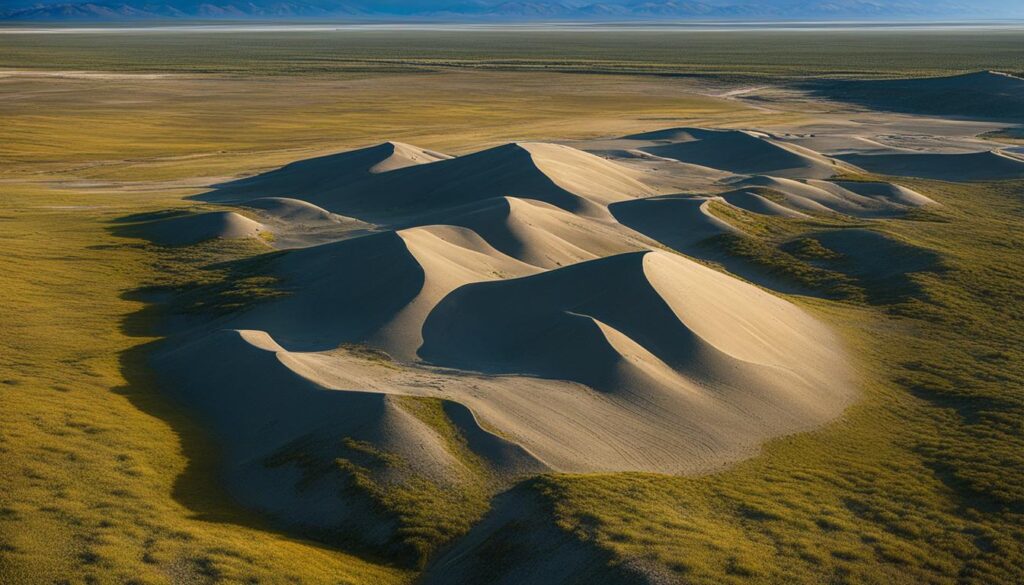
Kobuk Valley National Park holds a significant place in history, with archaeological sites that reveal the presence of human occupation dating back 12,000 years. These sites provide a glimpse into the lives of early inhabitants, including the Inupiaq Eskimos who still pursue caribou within the park. It is a unique opportunity to explore the rich cultural heritage of the region.
“The archaeological sites in Kobuk Valley National Park offer a window into the past, allowing us to connect with the ancient people who once thrived in this harsh, yet stunning environment.” – Archaeologist John Smith
One notable site within the park is Onion Portage, where visitors can discover Giddings’ Cabin, a traditional log building that exemplifies the architectural methods of the past. This well-preserved structure stands as a testament to the resourcefulness and craftsmanship of the people who once called this land home.
Exploring these historical sites not only adds depth to the hiking experience in Kobuk Valley but also fosters a sense of appreciation for the resilient communities that have shaped the region over thousands of years.
The Importance of Preserving History
Preserving the historical significance of Kobuk Valley National Park is crucial for future generations. It allows us to learn from the past and gain a deeper understanding of our shared human heritage. By protecting and respecting these archaeological sites, we ensure that the stories and cultural traditions of the people who once lived here continue to be celebrated and appreciated.
| Historical Sites | Significance |
|---|---|
| Onion Portage | Home to Giddings’ Cabin, an example of traditional log building methods |
| Caribou Crossing | Preserves evidence of caribou migration routes and hunting practices |
| Baird Mountains Petroglyphs | Features ancient rock carvings created by early inhabitants |
By exploring these archaeological sites responsibly and leaving them undisturbed, visitors contribute to the preservation of Kobuk Valley’s historical legacy. It is an opportunity to connect with the past and gain a deeper appreciation for the natural and cultural wonders that make this park a truly extraordinary destination.
Geological Wonders in Kobuk Valley National Park

Kobuk Valley National Park is home to fascinating geological features that make it a truly unique destination. One of the park’s highlights is the Great Kobuk Sand Dunes, the largest active sand dunes in the Arctic. These towering dunes, reaching heights of 100 feet, create a mesmerizing landscape that will leave you in awe. The sand dunes offer a variety of hiking opportunities, from easy walks to more challenging treks. Whether you’re exploring the vastness of the dunes or sandboarding down their slopes, the Great Kobuk Sand Dunes are a must-see attraction in the park.
Adjacent to the Great Kobuk Sand Dunes are the Little Kobuk Sand Dunes and the Hunt River Sand Dunes. These smaller dune formations provide additional opportunities for exploration and discovery. As you hike through the sand, you’ll experience a sense of tranquility and solitude, surrounded by the untouched beauty of nature. The sand dunes are constantly shifting and changing, creating a dynamic environment that is both intriguing and captivating.
Geological Features in Kobuk Valley National Park
| Geological Feature | Description |
|---|---|
| Great Kobuk Sand Dunes | The largest active sand dunes in the Arctic, reaching heights of 100 feet. Ideal for sandboarding and hiking. |
| Little Kobuk Sand Dunes | Smaller sand dunes adjacent to the Great Kobuk Sand Dunes, offering opportunities for exploration. |
| Hunt River Sand Dunes | Sand dunes located near the Hunt River, providing a unique landscape in the park. |
“The geological wonders of Kobuk Valley National Park, especially the Great Kobuk Sand Dunes, offer a truly captivating experience for hikers and nature enthusiasts. The towering dunes, shifting sands, and untouched beauty of these formations create a sense of wonder and adventure. Exploring the sand dunes allows you to witness the incredible power of nature and appreciate the unique geological history of the park.”
As you hike through Kobuk Valley National Park, take the time to appreciate and marvel at the geological wonders that surround you. The sand dunes are just one of the many incredible features that make this park a truly special place. From the vastness of the Great Kobuk Sand Dunes to the smaller formations of the Little Kobuk Sand Dunes and the Hunt River Sand Dunes, the geological diversity of Kobuk Valley will leave a lasting impression.
Wildlife in Kobuk Valley National Park
Kobuk Valley National Park is a haven for wildlife enthusiasts, offering a unique opportunity to witness diverse animal species in their natural habitat. From majestic bears to the spectacular caribou migration, the park is home to a wide range of wildlife that can be observed during your hiking adventure.
One of the most iconic species in Kobuk Valley is the bear. Here, visitors can encounter both grizzly bears and black bears roaming the park. It’s essential to exercise caution and follow proper wildlife safety measures when hiking in bear country, such as carrying bear spray and making noise to alert bears of your presence.
The park is also famous for the caribou migration, where approximately 500,000 caribou pass through the valley during their annual journey. Witnessing this incredible natural phenomenon is an awe-inspiring experience and truly highlights the untouched wilderness of Kobuk Valley.
For bird enthusiasts, Kobuk Valley National Park offers excellent opportunities for birdwatching. The park is home to a variety of bird species, including the Arctic tern and numerous waterfowl. Hikers can enjoy observing these beautiful creatures as they soar through the air or gracefully swim in the park’s pristine rivers and lakes.
| Wildlife in Kobuk Valley National Park | Description |
|---|---|
| Bears | Kobuk Valley is home to both grizzly bears and black bears, providing a chance to observe these majestic creatures in their natural habitat. |
| Caribou Migration | Approximately 500,000 caribou migrate through the valley, creating one of the last great migrations on Earth. |
| Birdwatching | Kobuk Valley offers excellent opportunities for birdwatching, with a variety of bird species, including the Arctic tern and waterfowl. |
Exploring the wildlife in Kobuk Valley National Park adds an extra layer of excitement and wonder to your hiking experience. Remember to always respect the animals, keep a safe distance, and adhere to the park’s guidelines to ensure both your safety and the well-being of the wildlife.
Scenic Viewpoints in Kobuk Valley National Park
Kobuk Valley National Park is a treasure trove of stunning scenic viewpoints that showcase the untouched beauty of the Arctic landscape. One of the most breathtaking spots in the park is the Jade Mountains viewpoint. Perched on top of a bluff, this viewpoint offers panoramic views of the rugged mountains, with their jade-colored slopes reflecting the golden rays of the sun. It’s a sight that will leave you in awe of the vastness and grandeur of nature.
Another must-visit location for panoramic views is the Great Kobuk Sand Dunes. As you climb to the top of these towering sand dunes, a mesmerizing landscape unfolds before your eyes. Endless stretches of pristine sand stretch as far as the eye can see, blending seamlessly with the clear blue sky. From this vantage point, you can truly appreciate the unique geological features of the park and marvel at the forces of nature that have shaped it over thousands of years.
Exploring these scenic viewpoints is an opportunity to immerse yourself in the tranquility of Kobuk Valley National Park. It’s a chance to escape the hustle and bustle of everyday life and connect with the majesty of the natural world. So, don’t forget to bring your camera and capture the beauty of these panoramic views forever.
Table: Comparing Scenic Viewpoints in Kobuk Valley National Park
| Viewpoint | Location | Key Features |
|---|---|---|
| Jade Mountains viewpoint | Located on a bluff overlooking the Jade Mountains | Panoramic views of the rugged mountains and jade-colored slopes |
| Great Kobuk Sand Dunes | Located within the sand dune area of the park | Endless stretches of pristine sand blending with the clear blue sky |
As you can see, both the Jade Mountains viewpoint and the Great Kobuk Sand Dunes offer unique and awe-inspiring views. Whether you’re captivated by the majestic mountains or drawn to the vastness of the sand dunes, these scenic viewpoints will leave a lasting impression on your hiking journey in Kobuk Valley National Park.
Trip Planning for Hiking in Kobuk Valley National Park
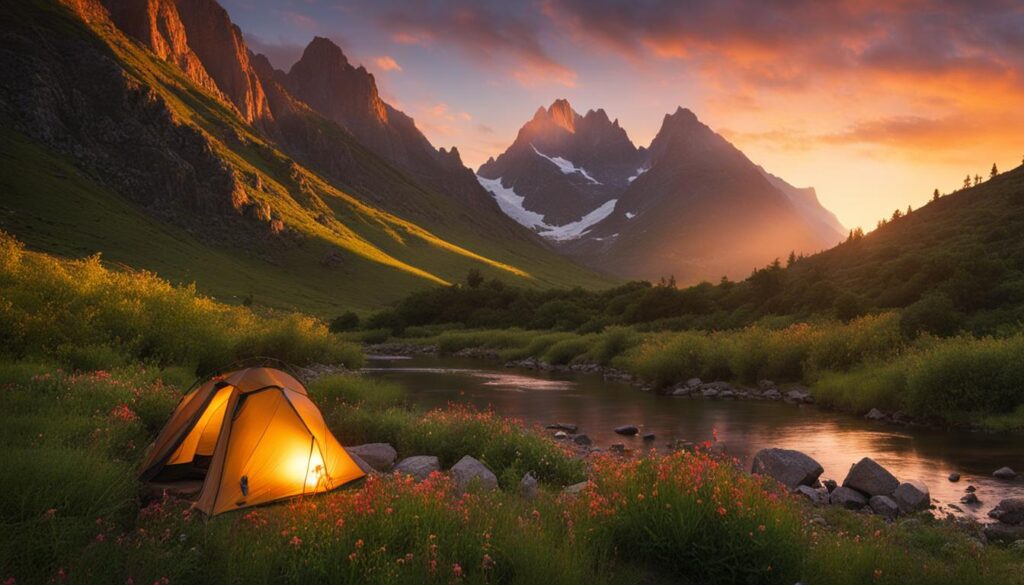
When it comes to planning a hiking trip in Kobuk Valley National Park, there are a few key factors to consider. First and foremost, determining how to get to the park is crucial. As there are no roads leading to Kobuk Valley, the best way to access it is by catching a commercial flight to either Kotzebue or Bettles, and then taking a bush plane to the park. This remote location adds to the allure of Kobuk Valley, as it ensures a true wilderness experience.
Another important aspect of trip planning is camping in Kobuk Valley. Since there are no designated campsites within the park, it’s essential to consult with park rangers and plan your camping locations in advance. They can provide valuable insights on suitable camping spots and ensure that you have a safe and enjoyable experience. Whether you prefer pitching a tent or utilizing a camper, there are options available for various camping preferences.
Before embarking on your hiking adventure, a visit to the Northwest Arctic Heritage Center in Kotzebue is highly recommended. Serving as the Visitor Center for the park, it offers a wealth of information on Kobuk Valley, including trail maps, safety guidelines, and weather updates. The knowledgeable staff can provide guidance on the best hiking routes for your skill level and interests.
With proper trip planning, you can make the most of your hiking expedition in Kobuk Valley National Park. From arranging transportation to mapping out camping locations and seeking guidance from the visitor center, these preparatory steps will ensure that you have a safe, enjoyable, and unforgettable experience in this remote and pristine wilderness.
Safety Tips for Hiking in Kobuk Valley National Park
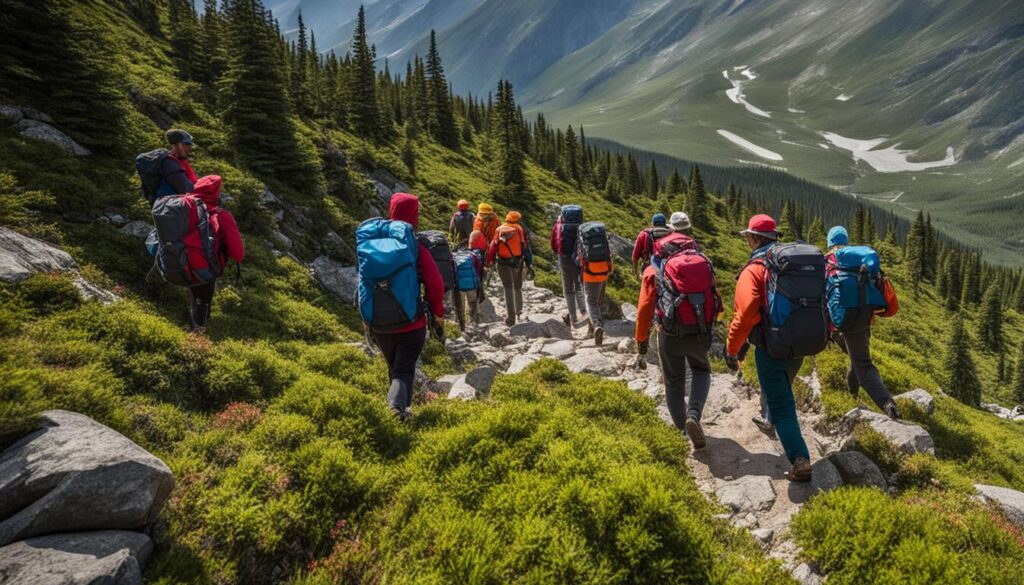
When embarking on a hiking adventure in Kobuk Valley National Park, it’s important to prioritize safety. The park’s extreme conditions, including cold temperatures and unpredictable weather, require hikers to be well-prepared. Here are some safety tips to keep in mind:
Plan Accordingly
- Research the park’s trails and choose hikes that are suitable for your skill level and experience.
- Check the weather forecast before heading out and be prepared for sudden changes in conditions.
- Inform someone of your hiking plans, including your intended route and expected return time.
Come Prepared
- Dress in layers and wear appropriate clothing for the weather, including hats, gloves, and sturdy footwear.
- Pack essential gear, such as a map, compass, GPS device, first aid kit, extra food, water, and emergency supplies.
- Carry bear spray for protection against potential wildlife encounters.
Practice Wildlife Safety
- Stay alert and make noise to avoid surprising wildlife, especially bears.
- Keep a safe distance from animals and never approach or feed them.
- Store food properly to prevent attracting wildlife to your campsite.
By following these safety tips, you can have a rewarding and safe hiking experience in Kobuk Valley National Park. Remember to respect the park’s extreme conditions and wildlife, and always prioritize your well-being.
| Safety Tips | Importance |
|---|---|
| Plan Accordingly | Researching and planning your hike helps ensure you choose the right trail and stay informed about any potential hazards. |
| Come Prepared | Having the necessary gear and supplies can make a significant difference in your comfort and safety while hiking in extreme conditions. |
| Practice Wildlife Safety | Respecting and understanding the park’s wildlife is crucial for both your safety and the well-being of the animals. |
Conclusion
Kobuk Valley National Park offers a thrilling outdoor adventure for those seeking a true wilderness experience. Whether you’re a seasoned hiker or a nature enthusiast looking to explore, this park has something for everyone.
With its diverse hiking trails, stunning scenery, and abundant wildlife, Kobuk Valley is a must-visit destination for outdoor enthusiasts. From the easy trails that showcase the park’s unique geological wonders to the challenging hikes that take you through rugged terrains, there are plenty of options to suit your hiking preferences.
Camping in Kobuk Valley allows you to fully immerse yourself in the beauty of this remote Alaskan paradise. As you explore the park, you’ll discover ancient archaeological sites and learn about the rich history of the region, adding depth to your adventure.
So, pack your hiking gear and prepare for an unforgettable journey in Kobuk Valley National Park. Discover the must-visit hiking spots, connect with nature, and experience the thrill of exploring one of the most remote and breathtaking destinations in the United States.
FAQ
Are there designated hiking trails in Kobuk Valley National Park?
While there are no formal hiking trails in the park, there are areas where visitors can explore on foot.
What are some easy hiking trails in Kobuk Valley National Park?
Some easy hiking trails in the park include the Great Kobuk Sand Dunes and Onion Portage.
What are some hard hiking trails in Kobuk Valley National Park?
Some hard hiking trails in the park include the ridgelines of the Baird Mountains and the tundra trek to reach the mountains from the river.
What is the best time to go hiking in Kobuk Valley National Park?
The summer months, from mid-June through July, are the best time for camping and hiking in Kobuk Valley.
What historical sites can be found in Kobuk Valley National Park?
Kobuk Valley contains archaeological sites that show evidence of human occupation dating back 12,000 years, including Giddings’ Cabin at Onion Portage.
What are the geological wonders in Kobuk Valley National Park?
The Great Kobuk Sand Dunes, Little Kobuk Sand Dunes, and Hunt River Sand Dunes are the unique geological features in the park.
What kind of wildlife can be seen in Kobuk Valley National Park?
Wildlife in the park includes grizzly bears, black bears, moose, wolverines, foxes, wolves, various bird species, and the migration of caribou.
Where can I find scenic viewpoints in Kobuk Valley National Park?
Scenic viewpoints can be found at Onion Portage and the Great Kobuk Sand Dunes, offering stunning views of the surrounding landscape.
How can I plan a trip to Kobuk Valley National Park?
Visitors can reach the park by catching a commercial flight to Kotzebue or Bettles and then taking a bush plane to the park. There are no designated campsites within the park, so it’s important to plan your camping locations in advance.
What safety precautions should I take when hiking in Kobuk Valley National Park?
Dress appropriately for the weather, bring essential gear like rain gear and warm layers, and carry maps, compasses, and GPS units for navigation. Be aware of wildlife safety measures and properly store food to prevent attracting animals.

